If you’re a fan of Japanese cuisine, you’ve probably come across vegetable gyoza – delicious, bite-sized dumplings filled with a flavorful combination of tofu, cabbage, mushrooms, and other veggies. But did you know that you can easily recreate this popular dish in the comfort of your own kitchen?
With just a handful of ingredients and some simple techniques, you can whip up a batch of homemade vegetable gyoza that is not only delicious but also vegan-friendly. Yes, that’s right, these gyoza dumplings are completely plant-based, making them a perfect option for those following a vegan diet or looking to incorporate more meatless meals into their routine.
In this article, I will share with you an easy homemade vegetable gyoza recipe that will have you impressing your friends and family with your culinary skills. From making the perfect gyoza wrappers to folding them like a pro, I’ve got you covered every step of the way. So let’s dive in and get cooking!
Key Takeaways:
- Homemade vegetable gyoza is a delicious and satisfying Japanese dish.
- These gyoza dumplings are filled with a light and flavorful combination of tofu, cabbage, mushrooms, and other vegetables.
- They are completely vegan-friendly, making them suitable for both vegetarians and vegans.
- Making homemade gyoza is easier than you think, and with a few simple techniques, you can create perfect plant-based potstickers at home.
- Stay tuned for the step-by-step recipe and tips to make your vegetable gyoza a success!
Why You’ll Love This Vegetable Gyoza
There are several reasons why this Vegetable Gyoza recipe is a must-try.
- Delicious Flavor: This Vegetable Gyoza is incredibly delicious, with a delightful mix of tofu, vegetables, and mushrooms. The combination of flavors creates a mouthwatering filling that will leave you craving more.
- Light and Healthy: Unlike traditional gyoza, this recipe offers a light and healthy alternative. The filling is packed with nutritious ingredients like tofu, vegetables, and mushrooms, making it a great choice for those looking for a wholesome and balanced meal.
- Versatile Dish: Whether you’re a vegetarian, vegan, or meat-eater, this Vegetable Gyoza is a versatile dish that can be enjoyed by everyone. It’s a crowd-pleaser that can be served as an appetizer, main course, or even as a snack.
No matter your dietary preferences, you’ll find this Vegetable Gyoza to be a delicious and satisfying option. Its amazing taste, lightness, and versatility make it a favorite among gyoza enthusiasts and newcomers alike.
Stay tuned for the next section, where we’ll explore gyoza for beginners and how to make the perfect vegetable gyoza filling.
Gyoza for Beginners
Gyoza is a popular Japanese pan-fried dumpling dish that originated from China. While the classic gyoza is typically made with pork and cabbage filling, this vegetable gyoza recipe offers a delicious vegetarian and vegan option. Made with a combination of tofu, cabbage, carrots, mushrooms, and flavorful seasonings, this plant-based version is sure to please.
The dumpling skin used in gyoza is thin, resulting in a light and crispy texture when pan-fried. This makes the vegetable gyoza a great choice for beginners, as the thin skin is easier to work with compared to thicker dumpling wrappers. So, if you’re new to making gyoza, this recipe is the perfect place to start.
Whether you’re following a vegan or vegetarian diet, or simply looking to add more plant-based options to your meals, these vegetable gyoza are a delicious and flavorful choice. The combination of tofu, vegetables, and mushrooms creates a well-balanced filling that is both satisfying and packed with nutrients.
“Gyoza is the perfect dish to introduce you to the world of homemade dumplings. With a few simple ingredients and a little practice, you’ll be folding and pan-frying gyoza like a pro in no time!”
Why Choose Vegetable Gyoza?
There are many reasons why vegetable gyoza are a great choice for beginners. Firstly, the ingredients used in this recipe are easily accessible and can be found in most grocery stores. Secondly, the filling is versatile and can be customized to suit your taste preferences by adjusting the seasoning and vegetable proportions. Lastly, making gyoza at home is a fun and rewarding activity that allows you to experiment with flavors and create a dish that is tailored to your liking.
Get Started with Vegetable Gyoza
Now that you know the basics of vegetable gyoza, it’s time to get started with the recipe. Follow the step-by-step instructions below to make these delicious vegan dumplings. But first, take a look at this mouth-watering image of vegetable gyoza that will surely inspire you!
- Prepare the filling by combining tofu, cabbage, carrots, mushrooms, and seasonings in a bowl.
- Place a small spoonful of the filling in the center of each gyoza wrapper.
- Wet the edges of the wrapper with water and fold it in half, sealing the edges by pressing them together.
- Create pleats along the sealed edge of the gyoza wrapper for an authentic look.
- Heat a pan with oil, then place the gyoza in the pan, flat side down.
- Cook the gyoza until the bottom is golden brown and crispy.
- Add water to the pan and cover it, letting the gyoza steam until cooked through.
- Serve the vegetable gyoza hot with a dipping sauce of your choice.
Don’t worry if your first few attempts at folding gyoza aren’t perfect. With practice, your folding skills will improve, and you’ll be able to create beautifully folded gyoza that taste just as good as they look.
Now that you have a good understanding of vegetable gyoza and the reasons why they are a great option for beginners, it’s time to get in the kitchen and start making your own homemade vegan dumplings. Enjoy the process and savor the delicious flavors of this Japanese dish!
The Main Ingredients You’ll Need
When it comes to making delicious vegetable gyoza, it’s important to have the right ingredients. Here are the main components that will bring flavor and texture to your vegan dumplings:
1. Filling Ingredients:
Vegetable Gyoza:
- Firm tofu
- Cabbage
- Shiitake mushrooms
- King oyster mushrooms
- Carrots
- Onions
Seasonings:
- Soy sauce
- Miso
- Sesame oil
- Ginger
- Garlic
- Salt
- Pepper
These ingredients work together to create a flavorful and umami-packed filling for your vegetable gyoza. The combination of tofu, mushrooms, and vegetables gives the gyoza a satisfying texture, while the seasonings add depth of flavor.
2. Wrappers:
While the focus is on the filling, don’t forget about the gyoza wrappers. They play a crucial role in holding everything together. You can either buy pre-made gyoza wrappers from a store or try making your own at home.
3. Dipping Sauce:
No gyoza is complete without a delicious dipping sauce. You can make a traditional soy-based dipping sauce by combining soy sauce, rice vinegar, sesame oil, and a touch of chili oil or create your own unique flavor combination.
With these ingredients in hand, you’re ready to embark on your vegetable gyoza making journey. Don’t forget to experiment and adjust the seasonings to suit your taste preferences, and enjoy the process of creating these delectable vegan dumplings.
The Right Gyoza Wrappers
When it comes to making vegetable gyoza, choosing the right gyoza wrappers is essential for achieving authentic Japanese flavors. While Japanese brand gyoza wrappers are ideal as they are thinner and smaller, they might not be readily available in your area. But fret not, as you can easily make your own gyoza wrappers at home using simple ingredients.
To make homemade gyoza wrappers, all you need is flour, salt, and water. Blend these ingredients together until a smooth dough forms. Next, roll out the dough thinly and use a glass or cookie cutter to cut out circles, ensuring they are of uniform size. Dust them with flour or cornstarch to prevent sticking.
Alternatively, if time is of the essence, you can also use frozen gyoza wrappers. Just defrost them before use and they will work just as well. Remember to keep the wrappers moist by covering them with a damp paper towel or plastic wrap to prevent them from drying out.
| Option | Description |
|---|---|
| Japanese Brand Gyoza Wrappers | Thinner and smaller; ideal for authentic Japanese-style gyoza |
| Homemade Gyoza Wrappers | Made with flour, salt, and water; allows customization to desired thickness |
| Frozen Gyoza Wrappers | Convenient option; defrost before use to ensure pliability |
Whether you choose to make your own gyoza wrappers or opt for the convenience of frozen ones, both options will yield deliciously crispy and flavorful vegan dumplings that will delight your taste buds.
How to Make Gyoza Wrappers at Home
Making your own gyoza wrappers at home is a fun and rewarding process. By following a few simple steps, you can create perfectly thin and delicious homemade gyoza wrappers. With just flour, salt, and water, you’ll be on your way to making authentic vegetable gyoza in no time.
Gather Your Ingredients
To make homemade gyoza wrappers, you’ll need the following ingredients:
- 2 cups of all-purpose flour
- 1/2 teaspoon of salt
- 3/4 cup of warm water
Ensure that you have these ingredients ready before proceeding to the next steps.
Knead the Dough
In a large mixing bowl, combine the flour and salt. Gradually add the warm water while stirring with a fork or chopsticks. Once the dough starts to come together, knead it with your hands until the dough becomes smooth and elastic. This should take about 5-7 minutes of kneading.
Roll Out the Dough
Once the dough is smooth, divide it into 2 equal portions. Take one portion and lightly flour your work surface. Roll out the dough into a long rectangle, approximately 1/8 inch thick. Make sure to keep the remaining dough covered with a damp cloth or plastic wrap to prevent it from drying out.
Cut Out the Wrappers
Using a round glass or cookie cutter, cut out circles from the rolled-out dough. Aim for wrappers that are approximately 3-4 inches in diameter. Place the cut-out wrappers on a floured surface and cover them with a damp cloth or plastic wrap to prevent them from drying out.
Dust the Wrappers
To prevent the gyoza wrappers from sticking together, dust them lightly with cornstarch or flour. This will also help to give them a slightly crisp texture when cooked.
Now that you have your homemade gyoza wrappers ready, you can proceed to fill them with your desired vegetable filling. The process of making your own gyoza wrappers adds a personal touch to your homemade vegetable gyoza, making them even more special.
How to Fold Gyoza Wrappers
Folding gyoza wrappers may seem intimidating at first, but with a little practice, it can become an enjoyable task. There are different folding techniques, but the most common one involves the following steps:
- Wet the edge of the gyoza wrapper with water or a cornstarch slurry to ensure a proper seal.
- Fold the wrapper in half, creating a half-moon shape, and press the edges together to seal.
- Starting from the center towards the right side, make small pleats along the top edge of the wrapper. Pinch the pleats firmly to seal the gyoza.
- Repeat the pleating process on the other side of the gyoza wrapper, ensuring that both sides match in appearance.
By following these steps, you can create beautifully folded gyoza that not only look impressive but also hold the filling securely during cooking.
Note: For a visual demonstration of the folding technique, refer to the image below:
Tips for Perfectly Folded Gyoza
Folding gyoza wrappers requires a bit of finesse, but with these helpful tips, you’ll be able to achieve perfectly folded gyoza every time:
- Ensure the wrapper’s edge is well-sealed to prevent any leakage during cooking.
- Avoid overfilling the gyoza wrapper, as this may make folding difficult and result in a messy dumpling.
- Practice makes perfect! Don’t be discouraged if your first few attempts aren’t perfect. With time, you’ll become more confident and skilled at folding gyoza.
| Folding Technique | Description |
|---|---|
 |
Folding technique 1 involves creating pleats from the center towards the right side of the gyoza wrapper. |
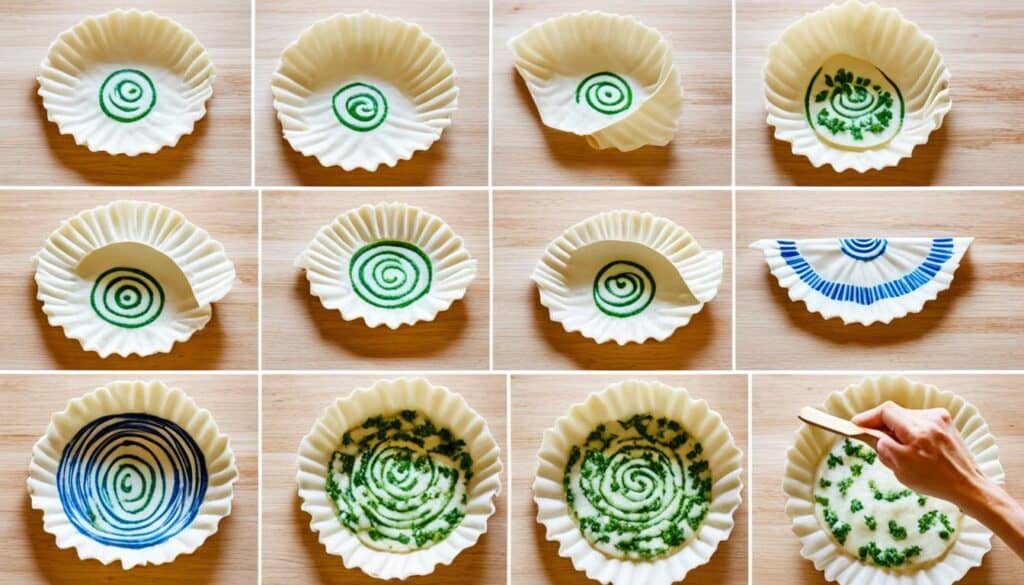 |
Folding technique 2 involves making pleats from the center towards the left side of the gyoza wrapper. |
| Folding technique 3 is a combination of pleats from both sides, resulting in a decorative and well-folded gyoza. |
Discovering different folding techniques can add variety to your gyoza presentation and make your homemade dumplings even more visually appealing.
5 Important Tips on Making Gyoza
When it comes to making delicious vegetable gyoza, there are a few essential tips to keep in mind. These tips will help you achieve perfectly cooked, flavorful, and crispy dumplings that will impress your taste buds and guests. So, let’s dive right in!
1. Cut Ingredients Into Uniform Shapes and Sizes
One crucial factor in making vegetable gyoza is to ensure that all the ingredients are cut into uniform shapes and sizes. This step ensures even cooking throughout the dumplings, resulting in a harmonious blend of flavors and textures.
2. Minimize Moisture in the Filling
To prevent the gyoza skin from becoming soggy, it is essential to minimize moisture in the filling. This can be achieved by properly draining and squeezing out excess liquid from ingredients such as tofu and vegetables. A drier filling will help maintain the crispness of the gyoza.
3. Avoid Air Pockets
While filling the gyoza wrappers, it’s crucial to avoid air pockets. These air pockets can cause uneven cooking and result in undercooked or mushy dumplings. To eliminate air pockets, press the edges of the wrapper firmly together, ensuring a tight seal.
4. Pan-Fry Until Golden Brown Before Steaming
For that coveted crispy texture, it’s best to pan-fry the gyoza until golden brown before adding water to steam them. The initial pan-frying process creates a crispy bottom crust that adds an irresistible crunch to your gyoza.
5. Pan-Fry Again After Steaming
After steaming, don’t forget to give your gyoza an extra touch of crispness by pan-frying them again. This quick second fry helps re-crisp the bottoms, enhancing the overall texture and flavor of the dumplings.
By following these tips, you’ll be well on your way to mastering the art of making vegetable gyoza. So, get ready to create mouthwatering vegan dumplings that are sure to impress!
How to Store Gyoza (Meal Prep)
Properly storing gyoza is essential to preserve their taste and texture for future enjoyment. Whether you have leftovers or want to prepare a batch of vegan dumplings in advance, here’s what you need to know about storing vegetable gyoza.
Refrigeration:
If you plan to consume the gyoza within the next couple of days, refrigeration is a convenient storage option. Follow these steps:
- Place the cooked or uncooked gyoza in an airtight container.
- Ensure that the gyoza are arranged in a single layer to prevent sticking together.
- Label the container with the date of preparation to keep track of freshness.
- Store the container in the refrigerator, where the gyoza can stay fresh for up to 2 days.
Freezing:
If you want to store gyoza for an extended period, freezing is the best option. The freezing process helps maintain the quality and taste of the vegan dumplings. Here’s how to freeze gyoza:
- Arrange the cooked or uncooked gyoza in a single layer on a baking tray or board.
- Make sure there is space between each gyoza to prevent them from sticking together.
- Place the tray or board in the freezer and allow the gyoza to freeze completely.
- Once frozen, transfer the gyoza to a freezer bag or airtight container.
- Label the packaging with the date of freezing for easy reference.
Cooking Frozen Gyoza:
One of the benefits of freezing gyoza is the ability to cook them straight from the freezer, eliminating the need for defrosting. To cook frozen gyoza:
- Preheat a non-stick skillet or frying pan over medium heat.
- Add a small amount of oil to the pan, enough to cover the bottom.
- Place the frozen gyoza in the pan, ensuring they are in a single layer.
- Cook the gyoza for 2-3 minutes or until the bottoms turn golden brown.
- Once the bottoms are browned, add a small amount of water to the pan, enough to cover the bottom partially.
- Cover the pan and steam the gyoza for an additional 4-5 minutes or until the filling is cooked through and the wrappers are translucent.
- Remove the lid and cook the gyoza uncovered for another 1-2 minutes to crisp up the bottoms.
- Transfer the cooked gyoza to a plate and serve them hot with your favorite dipping sauce.
With refrigeration and freezing methods, storing your vegetable gyoza is easy and convenient. Whether you choose to enjoy them within a couple of days or save them for later, proper storage ensures that your gyoza taste just as delicious as when they were freshly made.
Gyoza Storage Methods
| Storage Method | Duration | Instructions |
|---|---|---|
| Refrigeration | Up to 2 days | Place gyoza in an airtight container in the refrigerator. |
| Freezing | Several weeks | Arrange gyoza in a single layer on a tray, freeze, then transfer to a freezer bag or container. |
| Cooking Frozen Gyoza | N/A | Cook gyoza straight from the freezer without defrosting. |
Itadakimasu!
Itadakimasu is a Japanese expression that is said before starting a meal to express gratitude for the food. It is a fun and enjoyable activity to make vegetable gyoza at home and can be a great way to get your family or loved ones involved. By following the recipe and tips provided, you can create delicious and satisfying vegetable gyoza that everyone will love.
Making vegetable gyoza is not just about preparing a meal; it’s about creating an experience. Gather your loved ones in the kitchen, roll up your sleeves, and enjoy the process of making these vegan dumplings together. From kneading the dough to folding the gyoza wrappers, each step is an opportunity to bond and enjoy the anticipation of the mouth-watering flavors that await.
As you cook the vegetable gyoza, the aroma will fill the air, creating an atmosphere of warmth and excitement. The sound of the sizzling dumplings in the pan will add to the anticipation of the first bite. And when you finally sit down to enjoy the vegetable gyoza, the joy and gratitude for the food will be shared by all.
Whether you serve the vegetable gyoza as an appetizer, snack, or main course, they are sure to delight your taste buds and leave you wanting more. The combination of the flavorful filling and the crispy texture of the gyoza wrapper is a match made in culinary heaven.
So, let’s say it together: Itadakimasu! Express your gratitude for the food, and savor each bite of these delectable vegetable gyoza. Enjoy the experience of cooking and eating these vegan dumplings, and create lasting memories with your loved ones.
Tips for enjoying gyoza to the fullest:
- Serve the gyoza with a dipping sauce made from soy sauce, rice vinegar, and a splash of sesame oil.
- Sprinkle some toasted sesame seeds or chopped green onions on top for added flavor and garnish.
- Pair the vegetable gyoza with a side of steamed rice or a refreshing salad for a well-rounded meal.
- Experiment with different fillings and flavors to create your own signature gyoza recipe.
Itadakimasu! Gyoza Recipe:
Here’s a quick recap of the recipe and techniques:
1. Prepare the filling by combining tofu, cabbage, mushrooms, carrots, and seasonings.
2. Make or buy gyoza wrappers.
3. Place a spoonful of filling onto each wrapper, moisten the edges, and fold them into half-moons.
4. Pan-fry the gyoza until golden brown on the bottom.
5. Add water to the pan and cover to steam the gyoza.
6. Remove the lid and let the gyoza cook until the water evaporates and the bottoms crisp up again.
7. Serve the vegetable gyoza with your favorite dipping sauce and enjoy!
Conclusion
Making homemade vegetable gyoza is a rewarding experience that allows you to create a delicious and satisfying dish. Whether you’re a vegetarian, a vegan, or a meat-eater, these vegan dumplings are sure to please your taste buds. With a light and flavorful filling made from tofu, cabbage, mushrooms, and other fresh vegetables, and a crispy texture when pan-fried, these vegetable gyoza are a perfect choice for a plant-based potstickers meal.
By following the easy homemade gyoza recipe and the techniques provided, you can easily make these delightful dumplings in the comfort of your own kitchen. The recipe uses simple ingredients and provides step-by-step instructions, making it accessible for beginners. Whether you’re hosting a dinner party or enjoying a cozy night in, these vegetable gyoza will impress your guests and satisfy your cravings for Asian flavors.
So why order takeout when you can make your own homemade vegetable gyoza? Take a culinary adventure and immerse yourself in the joy of creating these delectable dumplings. With their wholesome ingredients, delightful taste, and crunchy texture, these vegan dumplings are a crowd-pleaser that will leave everyone craving for more. Embrace your inner chef and enjoy the deliciousness of homemade vegetable gyoza!

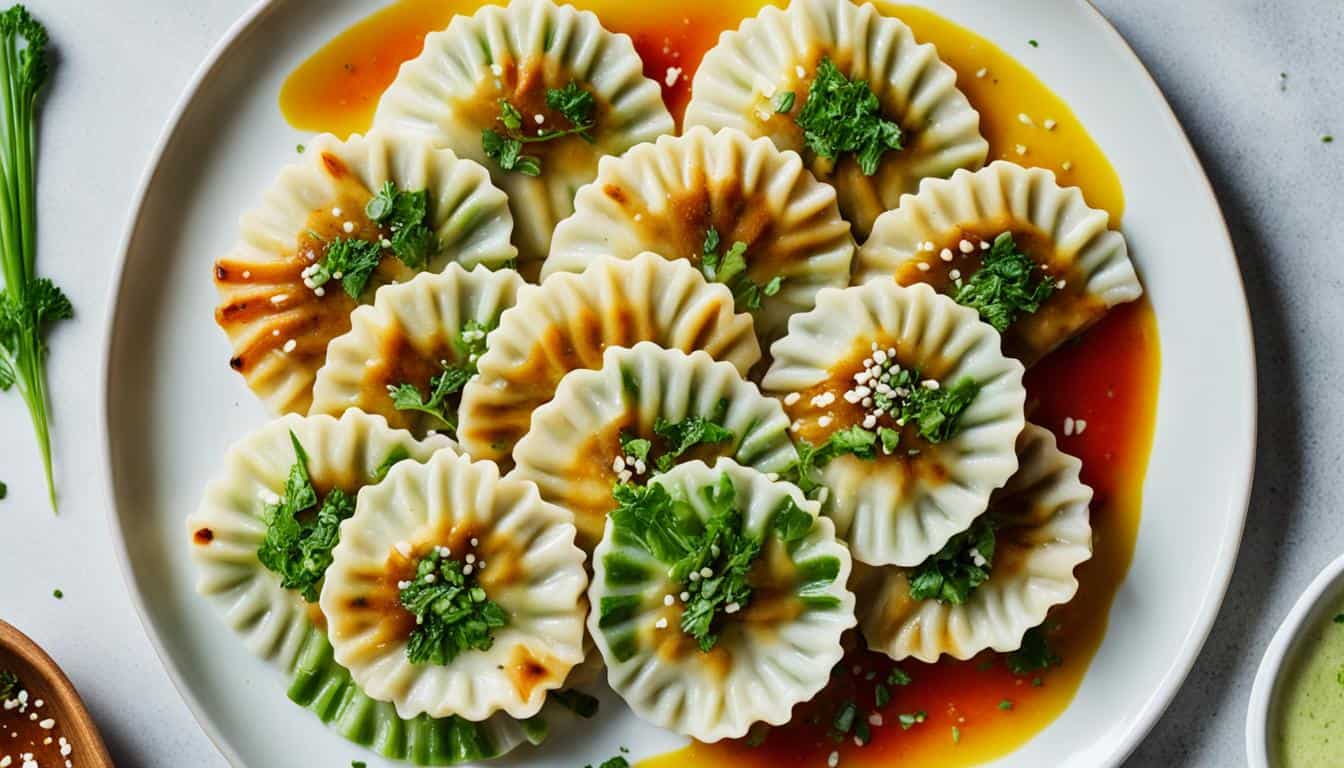
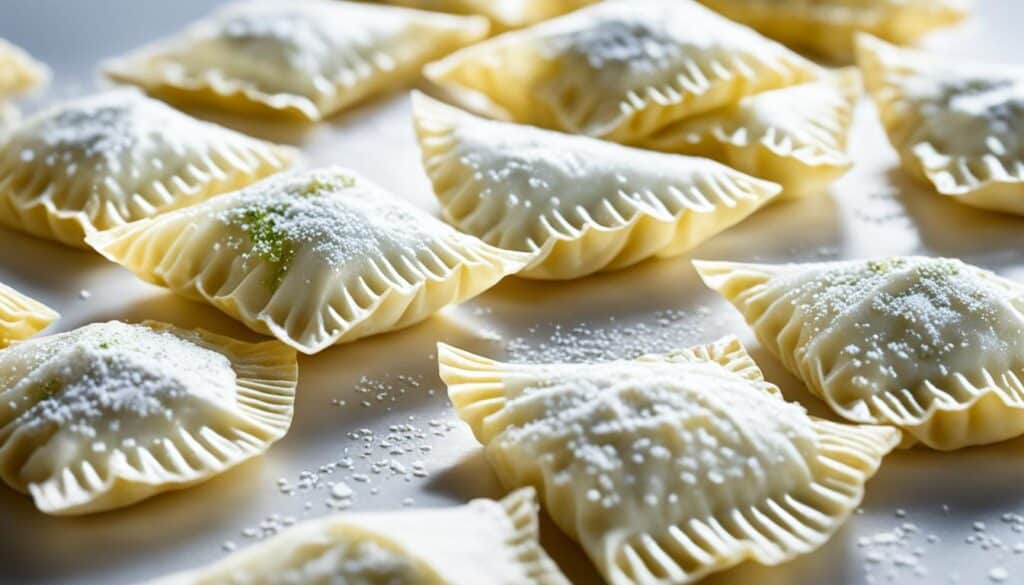
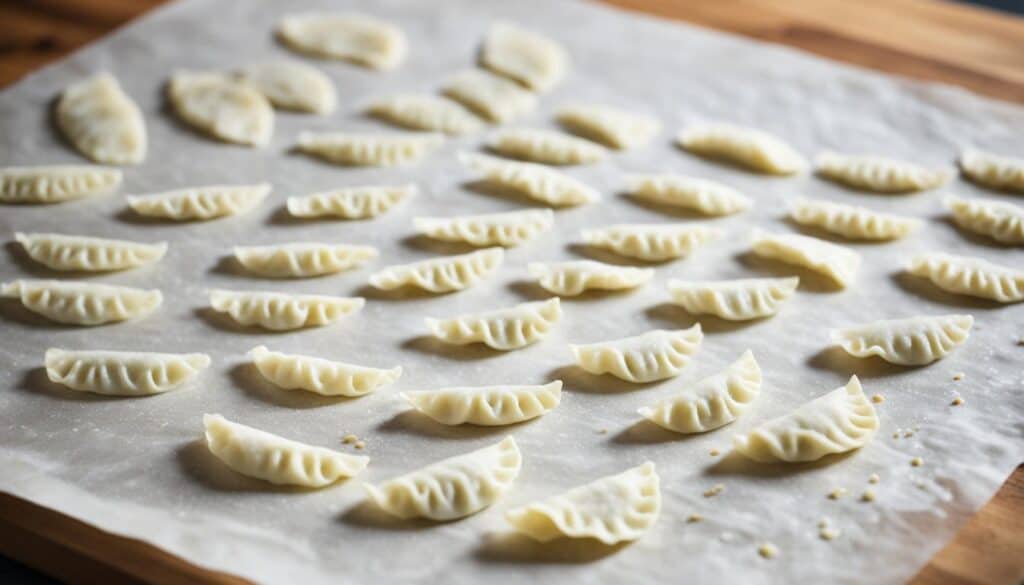
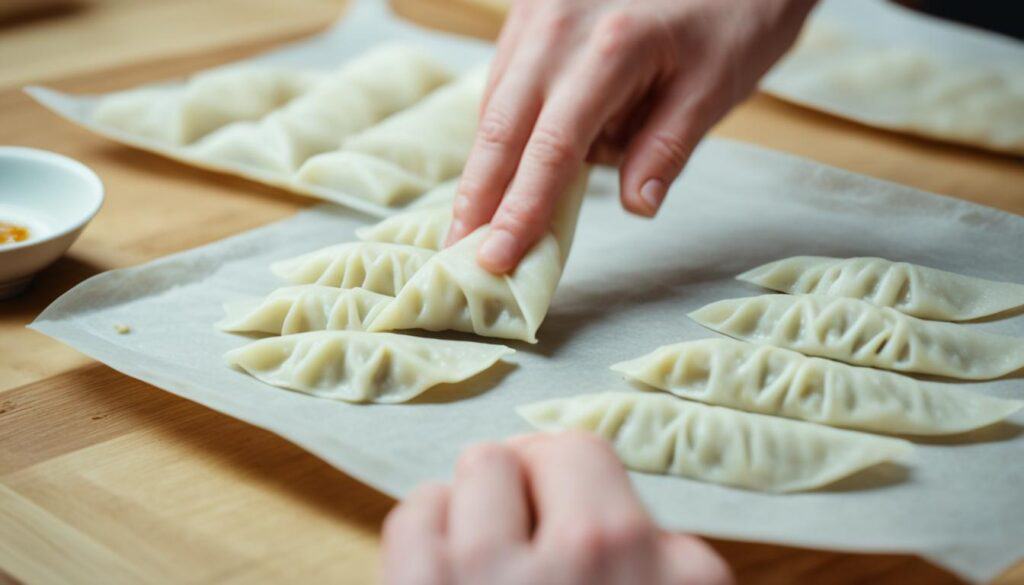



Leave a Reply